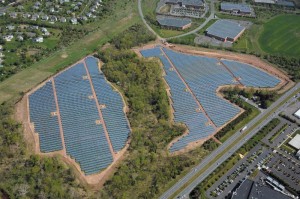 For the ninth time in the past 11 months, solar and wind energy dominated the new U.S. electrical generating capacity.
For the ninth time in the past 11 months, solar and wind energy dominated the new U.S. electrical generating capacity.
In it’s latest “Energy Infrastructure Update” report (with data through Nov. 30, 2014), the Federal Energy Regulatory Commission’s (FERC) Office of Energy Projects, states that wind energy and solar power combined provided more than 70 percent of the 873 megawatts (MW) of new U.S. electrical generating capacity placed into service in November 2014.
Fourteen new “units” of solar came on line for a total of 294-MW of capacity, led by MidAmerican Renewables LLC’s 250-MW Topaz Solar Farms expansion in California.
Also, three wind farms came on line last month, accounting for 333-MW of new generation in service. These included Stella Wind Farm’s 182-MW Panhandle Wind Farm Phase II expansion in Texas and the 150-MW Origin Wind Energy project in Oklahoma. New wind generating capacity this year thus far has more than doubled that for the same period in 2013 (2,525-MW vs. 1,112-MW).
“With only one month left in 2014, it has become a horse race between natural gas and renewable energy as to which will dominate new electrical generation for the year,” noted Ken Bossong, executive director of the SUN DAY Campaign. “Regardless of the winner, it is apparent that coal, oil, and nuclear will be left behind in the dust.”
Just a single new unit of natural gas came on-line last month — Wisconsin Electric Power Co’s 140-MW Valley Power Plant Unit 1 Repowering Project, as well as the first and only coal plant to come into service so far in 2014 — Great River Energy’s 106-MW lignite-fueled Spiritwood Station project in North Dakota.
For the ninth time in the past eleven months, renewable energy sources (i.e., biomass, geothermal, hydropower, solar, wind) accounted for the majority of new U.S. electrical generation brought into service. Natural gas took the lead in April and August.
Renewable energy sources now account for 16.44 percent of total installed operating generating capacity in the U.S.: water – 8.43 percent, wind – 5.42 percent, biomass – 1.38 percent, solar – 0.88 percent, and geothermal steam – 0.33 percent. Renewable energy capacity is now greater than that of nuclear (9.22 percent) and oil (3.97 percent) combined. (See footnote at end)
Of the 10,926-MW of new generating capacity from all sources installed since Jan. 1, 2014, 39 units of wind accounted for 2,525-MW (23.11 percent), followed by 235 units of solar – 2,203-MW (20.16 percent), 49 units of biomass – 282-MW (2.58 percent), 7 units of hydropower – 141-MW (1.29 percent), and 5 units of geothermal – 32-MW (0.29 percent). In total, renewables have provided 47.43 percent of new U.S. electrical generating capacity thus far in 2014.
The balance came from 46 units of natural gas – 5,513-MW (50.46 percent), 1 unit of coal – 106-MW(0.97 percent), 1 unit of nuclear – 71-MW (0.65 percent), 15 units of oil – 47-MW (0.43 percent), and 6 units of “other” – 7-MW (0.06 percent). Thus, new capacity from renewable energy sources in 2014 is 49 times that from coal, 73 times that from nuclear, and 110 times that from oil.
Note: Generating capacity is not the same as actual generation. Generation per MW of capacity (i.e., capacity factor) for renewables is often lower than that for fossil fuels and nuclear power. According to the most recent data (as of September 2014) provided by the U.S. Energy Information Administration, actual net electrical generation from renewable energy sources now totals a bit more than 13 percent of total U.S. electrical production; however, this figure almost certainly understates renewables’ actual contribution significantly because EIA does not fully account for all electricity generated by distributed renewable energy sources (e.g., rooftop solar).
— Solar Builder magazine
[source: http://solarbuildermag.com/news/solar-dominates-energy-generation/]

Leave a Reply
You must be logged in to post a comment.